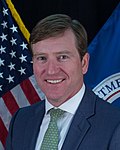| Director of the Cybersecurity and Infrastructure Security Agency | |
|---|---|
 | |
| United States Department of Homeland Security | |
| Constituting instrument | 6 U.S.C. § 113 |
| Inaugural holder | Chris Krebs |
| Formation | 2018 |
| Deputy | Madhu Gottumukkala |
| Website | www |
The director of the cybersecurity and infrastructure security agency is a high level civilian official in the United States Department of Homeland Security (DHS). The director, as head of the Cybersecurity and Infrastructure Security Agency at DHS, is the principal staff assistant and adviser to both the secretary of homeland security and the deputy secretary of homeland security for all DHS programs designed to reduce the nation's risk to terrorism and natural disasters. The director is appointed from civilian life by the president with the consent of the Senate to serve at the pleasure of the president.
Contents
The position was created in November 2018, replacing the position of Under Secretary of Homeland Security for National Protection and Programs.








